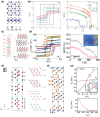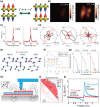van der Waals Magnets: Material Family, Detection and Modulation of Magnetism, and Perspective in Spintronics
- PMID: 33511010
- PMCID: PMC7816723
- DOI: 10.1002/advs.202002488
van der Waals Magnets: Material Family, Detection and Modulation of Magnetism, and Perspective in Spintronics
Abstract
van der Waals (vdW) materials exhibit great potential in spintronics, arising from their excellent spin transportation, large spin-orbit coupling, and high-quality interfaces. The recent discovery of intrinsic vdW antiferromagnets and ferromagnets has laid the foundation for the construction of all-vdW spintronic devices, and enables the study of low-dimensional magnetism, which is of both technical and scientific significance. In this review, several representative families of vdW magnets are introduced, followed by a comprehensive summary of the methods utilized in reading out the magnetic states of vdW magnets. Thereafter, it is shown that various electrical, mechanical, and chemical approaches are employed to modulate the magnetism of vdW magnets. Finally, the perspective of vdW magnets in spintronics is discussed and an outlook of future development direction in this field is also proposed.
Keywords: detection methods; material families; modulation methods; spintronics; van der Waals magnets.
© 2020 The Authors. Advanced Science published by Wiley‐VCH GmbH.
Conflict of interest statement
The authors declare no conflict of interest.
Figures














References
-
- Yan H., Feng Z., Shang S., Wang X., Hu Z., Wang J., Zhu Z., Wang H., Chen Z., Hua H., Lu W., Wang J., Qin P., Guo H., Zhou X., Leng Z., Liu Z., Jiang C., Coey M., Liu Z., Nat. Nanotechnol. 2019, 14, 131. - PubMed
-
- Vaz C. A. F., Bland J. A. C., Lauhoff G., Rep. Prog. Phys. 2008, 71, 056501.
-
- Mermin N. D., Wagner H., Phys. Rev. Lett. 1966, 17, 1133.
-
- Novoselov K. S., Geim A. K., Morozov S. V., Jiang D., Zhang Y., Dubonos S. V., Grigorieva I. V., Firsov A. A., Science 2004, 306, 666. - PubMed
-
- Bolotin K. I., Sikes K. J., Jiang Z., Klima M., Fudenberg G., Hone J., Kim P., Stormer H. L., Solid State Commun. 2008, 146, 351.
Publication types
LinkOut - more resources
Full Text Sources
Other Literature Sources
